Sicyopus exallisquamulus
Classification
Order: Perciformes Family: Gobiidae
Distribution
Described from the island of Halmahera in the Maluku Islands (also referred to as the Moluccan or Spice Islands) archipelago, Indonesia. It may have a wider range within the Maluku region and Indonesia in general since specimens collected on the island of Java are very similar indeed, for example (see images).
Habitat
Members of this genus are near-exclusive inhabitants of short coastal streams on tropical, often volcanic, islands, with typical habitats lying above waterfalls or cataracts. This makes them inaccessible to the majority of fishes although other gobies from the genus Stiphodon often occur syntopically, while amphidromous Macrobrachium spp. shrimp and neritid snails are the commonest invertebrates to be found.
Substrates are normally of bedrock with scattered jumbles of rocks and boulders, and while riparian/stream-side vegetation and submerged leaf litter are common aquatic plants aren’t usually present. The most favourable habitats all contain very clear, well-oxygenated water which, allied with the tropical sun, facilitates the development of a rich biofilm carpeting submerged surfaces.
Sicyopus spp. are such successful colonisers of these niche environments due to aspects of their morphology which allow them to utilise available food sources as well as employing a remarkable breeding strategy in which some species are known to climb waterfalls.
Maximum Standard Length
The largest specimen in the type series measured 51.3 mm and a size of 45 – 52 mm is reported in aquaria.
Aquarium SizeTop ↑
An aquarium with base dimensions of 60 ∗ 30 cm or equivalent is large enough for a pair or small group but use something bigger if you want to keep multiple species together since males are territorial to an extent.
Maintenance
These gobies aren’t too difficult to keep provided some basic requirements are met. Most importantly the water must be clean and well-oxygenated at all times so we suggest the use of either an over-sized filter, additional powerheads, flow pumps, or airstones. While torrential conditions are unnecessary a turnover of 10-15 times tank volume per hour is recommended, though with good oxygenation a lower rate of 5-10 times per hour is feasible.
Base substrate can either be of gravel, sand or a mixture of both to which should be added a layer of water-worn rocks and pebbles of varying sizes. Aged driftwood can also be used but avoid new pieces since these usually leach tannins which discolour the water and reduce the effectiveness of artificial lighting, and these gobies naturally dwell in very clear water.
If keeping multiple males of one or more species structure the rockwork to form plenty of potential hiding places and broken lines-of-sight to reduce the likelihood of excessive aggression. Although not a feature of this species‘ natural habitat aquatic plants can be used with hardier genera such as Microsorum, Crinum, and Anubias likely to fare best.
Since they require stable water conditions these fishes should never be added to immature set-ups and a tightly-fitting cover is necessary since they’re able to climb glass and are prodigious jumpers. Weekly water changes of 30-50% tank volume should also be considered mandatory.
Water Conditions
Temperature: 22 – 28 °C; increased surface agitation is required to maintain dissolved oxygen levels towards the upper end of this range.
pH: 6.5 – 7.5
Hardness: 36 – 215 ppm
Diet
Appears to be a specialised predator since it does not graze biofilm in the aquarium but willingly accepts small live or frozen foods such as bloodworm, Artemia, Daphnia, etc. Reports suggest that dried foods are ignored completely, and that this species does not make a good companion for small (live) invertebrates.
Behaviour and CompatibilityTop ↑
Can be kept in a community provided tankmates are chosen with care. Peaceful, pelagic species which naturally inhabit well-oxygenated streams such as Tanichthys, Microdevario, or smaller Danio species are the best choices for the upper levels, but we’ve also seen members of this genus being maintained with various characins, small poeciliid livebearers and freshwater shrimp from the genera Caridinia and Neocaridina.
Other bottom-dwellers can include small loaches from genera such as Gastromyzon, Pseudogastromyzon, Barbucca, or Acanthopsoides, and in high-turnover set-ups obligate torrent-dwellers like Annamia, Homaloptera, etc. Avoid those that feed aggressively or are territorial, e.g., many Schistura spp.
Bigger fishes are best omitted entirely although in large set-ups it may be possible to add a few non-predatory, surface-dwelling species. The majority of cichlids and other territorial fishes inhabiting the lower reaches should be avoided entirely though.
Sicyopus spp. only appear to be loosely territorial when breeding so several can be kept together if sufficient space and suitable foods are available, and other stream-dwelling gobies such as Stiphodon, Sicyopterus, Rhinogobius, or Schismatogobius spp. also make good companions.
Though males aren’t necessarily gregarious females tend to exist in loose groups meaning a single male with two or more females is the recommended minimum purchase. Females of different species will group together but males appear able to differentiate between them.
Sexual Dimorphism
Adult males possess relatively long unpaired fins and the first dorsal-fin is noticeably extended compared with the second, whereas in females the unpaired fins and first dorsal-fin are not extended. The jaw is also more pronounced in males while the genital papilla is conical in shape, whereas in females it’s rectangular.
Males also display a greater degree of orange pigmentation on the lower part of the head and posteroventral portion of the body though this only develops fully in dominant individuals, with subdominant fish appearing more similar to the plainer females.
Reproduction
Observations of courtship behaviour and the occasional spawning exist but to date no-one has managed to raise fry of any Sicyopus species in aquaria.
This is undoubtedly attributable to their complex amphidromous breeding strategy in which adults live and spawn in freshwater streams with the initially pelagic post-hatch larvae are washed downstream where the post-larval fry spend the first part of their life developing in marine conditions. Once they reach a certain stage of development they begin to migrate upstream, a journey which sometimes includes spectacular climbs up and over waterfalls or other obstructions.
Amphidromy isn’t unique to members of Sicyopus and the strategy is employed by various related genera in the family Gobiidae alone. McDowall (2007) gave a list of potential benefits to fishes employing such a breeding strategy, hypothesising that it may facilitate colonisation of new islands emerging in volcanic areas and/or allow recolonisation of streams following events such as volcanic eruptions/rapid changes in water flow during the wet season.
He also considered that leaving the marine environment can be seen as a trade-off; since amphidromous gobies are often the only fishes found in their habitats predators are virtually non-existent, but the available food sources are far less diverse than in the ocean.
NotesTop ↑
Live colouration of this species was not included in the original description but the specimens in our images were identified by Dr. Ronald E. Watson, the principal author, as S. exallisquamulus. It’s normally misidentified and traded as the Sri Lankan endemic species Sicyopus jonklaasi.
It’s diagnosable from congeners by the following combination of characters: 14-15 pectoral-fin rays; both genders exhibit small, widely-spaced scales below the first dorsal-fin, these being shaped ctenoid in males and cycloid in females; both sexes possess lobed urogenital papillae; dorsal-fin rays 3 and/or 4 are filamentous in males.
Watson (1999) defined three subgenera within Sicyopus based mostly on dental morphology. <i>Juxtastiphodon</i> has closely-set, conical teeth in both jaws of which none are recurved, and lacks canines. <i>Sicyopus</i> has widely-spaced conical teeth in both jaws of which most are sharply recurved, and lacks canines. <i>Smilosicyopus</i> has slightly recurved conical teeth in the anterior portions of both jaws which are needle-like teeth laterally and not recurved, with 1-3 canines between the anterior and lateral teeth.
Keith et al. (2011) elevated Smilosicyopus to genus level based on the results of their phylogenetic analyses within which Sicyopus zosterophorus and species of the subgenus Smilosicyopus did not group together, thus rendering Sicyopus polyphyletic. The three Smilosicyopus spp. were found to form a single, well-defined clade with the genus Stiphodon as sister group while S. zosterophorus was recovered in a different clade and appeared more closely-related with members of Akihito and Lentipes.
A nomenclatural change was thus required and since S. zosterophorus is the type species of Sicyopus it retained the name with Smilosicyopus used for the other clade as previously suggested by Watson. No Juxtastiphodon species were included in the study.
The Gobiidae is the most speciose vertebrate family and notoriously problematic in terms of identifying members down to species level. Sicyopus is often included in the putative subfamily Sicydiinae which currently contains at least six other genera; Cotylopus, Lentipes, Parasicyidium, Sicydium, Sicyopterus, and Stiphodon. Sicyopus and Lentipes species are omnivorous or carnivorous whereas the others are mostly herbivorous.
All share a similar life-history with many endemic to a particular island or group of islands, though a few are widespread. They also share some morphological characters including pelvic fins modified into a sucking disc with a strong spine and thickened, highly-branched rays, at the posterior edge of which the pelvic-fin spines and first ray are joined by a membrane forming ‘fleshy pads’ at the tips of the spines. The tongue is also fused to the base of the mouth, a feature shared by some other gobiids.
The fused pelvic fins form a structure normally referred to as the ‘pelvic disc‘, a common feature among gobiids which is used to adhere to rocks and other submerged surfaces. In Sicyopus, as in Stiphodon, this is short-based and attached to the belly only between the fifth pair of fin rays whereas in other sicydiines it’s attached between all five rays (Watson, 2005).
The role of the disc in ascending waterfalls and cascades has given rise to the common names of ‘rock-climbing’ or ‘cling’ gobies for members of the Sicydiinae in general. They’re also sometimes referred to as ‘toothed-lip’ gobies in reference to the outwardly-orientated, replaceable teeth of the upper jaw.
Many of those being imported for the aquarium trade have proven difficult to identify for a number of reasons including:
– taxonomic confusion.
– lack of aquarium literature.
– incorrect labelling by exporters and subsequently shops.
– historical over-use of some names.
– likely trade of undescribed species without locality data.
– mixing of species at export facilities.
Thanks to Dr. Ronald E. Watson.
References
- Watson, R. E. and M. Kottelat, 2006 - Icthyological Exploration of Freshwaters 17(2): 121-128
Two new freshwater gobies from Halmahera, Maluku, Indonesia (Teleostei: Gobioidei: Sicydiinae). - Keith, P., C. Lord, J. Lorion, S. Watanabe, K. Tsukamoto, A. Couloux, and A. Dettai, 2010 - Marine Biology 158(2): 311-326
Phylogeny and biogeography of Sicydiinae (Teleostei: Gobiidae) inferred from mitochondrial and nuclear genes. - Keith, P., G. Marquet, and M. Pouilly, 2009 - Publications Scientific du Museum d'Histoire Naturelle, Paris 31 (3): 471-483
Stiphodon mele n. sp., a new species of freshwater goby from Vanuatu and New Caledonia (Teleostei, Sicydiinae), and comments about amphidromy and regional dispersion. - McDowall, R. M., 2007 - Fish and Fisheries 8(1): 1-13
On amphidromy, a distinct form of diadromy in aquatic organisms. - McDowall, R. M., 2009 - Reviews in Fish Biology and Fisheries 19(1): 1-8
Early hatch: a strategy for safe downstream larval transport in amphidromous gobies. - Parenti, L. R. and K. R. Thomas, 1998 - Journal of Morphology 237(3): 257-274
Pharyngeal Jaw Morphology and Homology in Sicydiine Gobies (Teleostei: Gobiidae) and Allies.

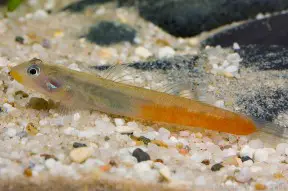
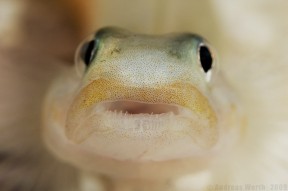
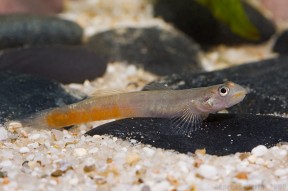
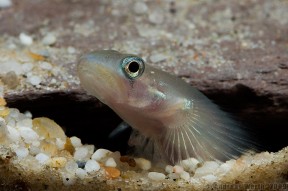
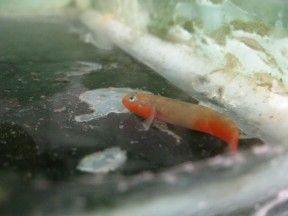
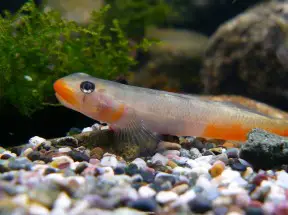
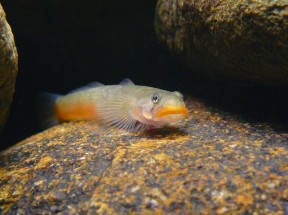
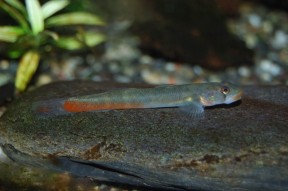
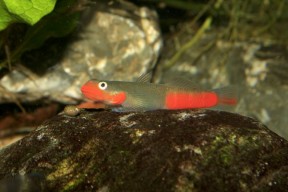
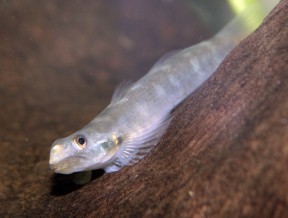

May 20th, 2015 at 3:07 pm
I was horrified today to find my sicyopus eating a half grown cherry shrimp alive. These fishes ignored my live moina feed. Looks like they are not micropredators.
May 21st, 2015 at 1:37 am
I think you have a point, and have edited accordingly. Thanks!